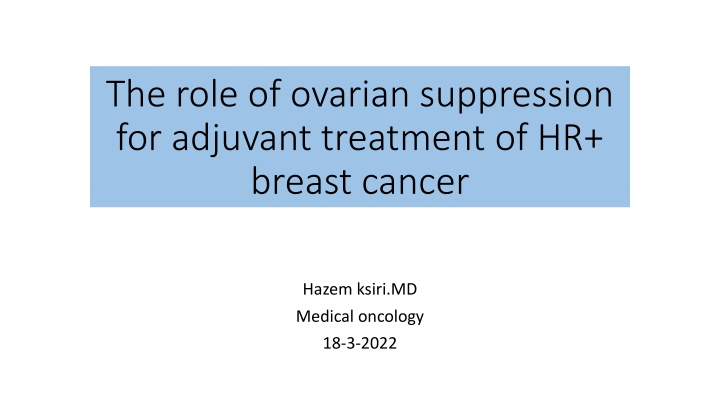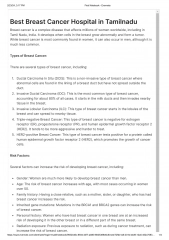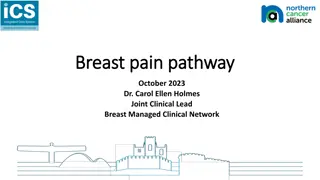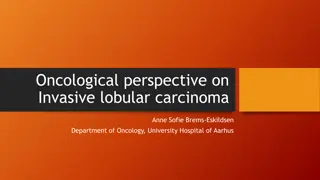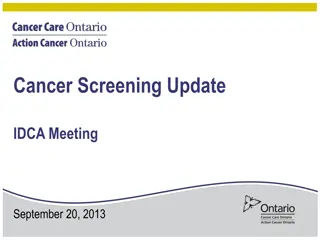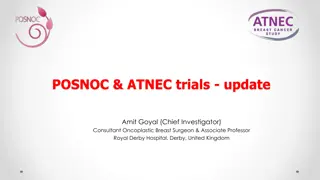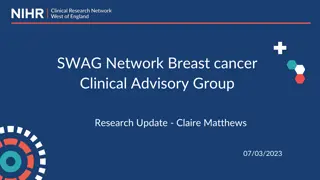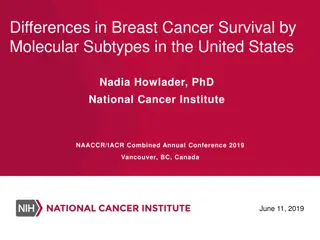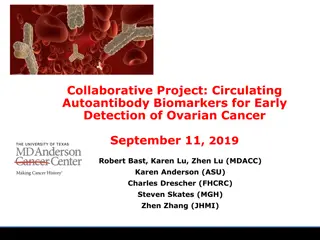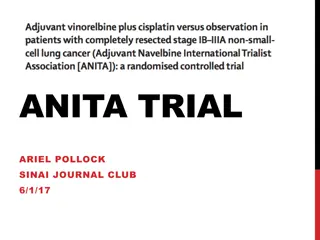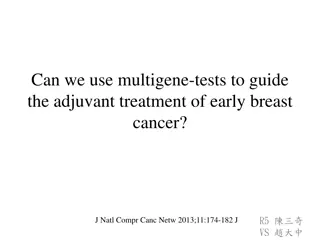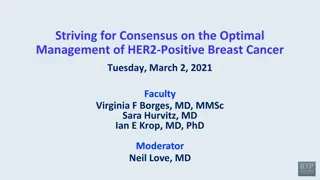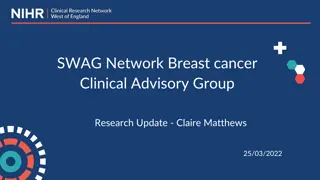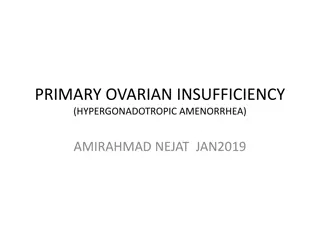Role of Ovarian Suppression in Adjuvant Treatment of HR+ Breast Cancer
Adjuvant chemotherapy and endocrine therapies play a crucial role in managing hormone receptor-positive (HR+) breast cancer. The debate on the benefits of adding ovarian function suppression (OFS) to endocrine therapy in premenopausal women continues. Younger age at diagnosis is associated with a higher risk of disease recurrence and aggressive tumor phenotypes. Tamoxifen has long been the standard adjuvant endocrine therapy. Explore the efficacy of OFS combined with adjuvant endocrine therapy through recent trials and reviews.
Download Presentation

Please find below an Image/Link to download the presentation.
The content on the website is provided AS IS for your information and personal use only. It may not be sold, licensed, or shared on other websites without obtaining consent from the author.If you encounter any issues during the download, it is possible that the publisher has removed the file from their server.
You are allowed to download the files provided on this website for personal or commercial use, subject to the condition that they are used lawfully. All files are the property of their respective owners.
The content on the website is provided AS IS for your information and personal use only. It may not be sold, licensed, or shared on other websites without obtaining consent from the author.
E N D
Presentation Transcript
The role of ovarian suppression for adjuvant treatment of HR+ breast cancer Hazem ksiri.MD Medical oncology 18-3-2022
Intoduction Adjuvant Chemotherapy and endocrine therapies are mainstays of treatment for early and advanced hormone receptor-positive (HR+) breast cancer. In premenopausal women with HR+ tumors, the benefits of adding ovarian function suppression (OFS) to endocrine therapy have been debated. for many years, tamoxifen monotherapy has been the standard of care for endocrine treatment in the adjuvant setting.
Statistics Younger age at diagnosis has long been recognized as a factor associated with higher risk of disease recurrence and death. in premenopausal women, breast cancer is often characterized by tumors with aggressive pathological phenotypes. younger patients have a higher proportion of more aggressive basal- like tumors, as well as a higher proportion of HER2-overexpressing tumors than older patients. Biology of breast cancer in young women.AzimHAJr,PartridgeAH.Breast Cancer Res. 2014 Aug 27; 16(4):427.
Statistics In premenopausal women, data show that approximately 65 80% of tumors are luminal-type HR-positive (HR+) tumors. Up to 1 in 3-4 women with eBC will still develop mBC, despite current advances in treatment. these patients are good candidates for treatment with endocrine therapy in the adjuvant setting. US incidence of breast cancer subtypes defined by joint hormone receptor and HER2 status.Howlader N, Altekruse SF, Li CI, Chen VW, Clarke CA, Ries LA, Cronin KA J Natl Cancer Inst. 2014 Apr 28; 106(5):
Tamoxifen Tamoxifen, a selective ER modulator (SERM), has been standard for adjuvant endocrine therapy in both premenopausal and postmenopausal women for many decades. patients with ER+ disease, 5 years of adjuvant tamoxifen treatment versus no adjuvant tamoxifen 1. reduced recurrence rates (RRs) by nearly 50% (RR 0.53) during years 0 4 and 30% (RR 0.68) in years 5 9 of follow up 2. breast cancer mortality was reduced by approximately 30% during the 15-year follow-up period. Relevance of breast cancer hormone receptors and other factors to the efficacy of adjuvant tamoxifen: patient-level meta-analysis of randomised trials.(EBCTCG)., Davies C, Godwin J, Gray R, Clarke M, Cutter D, Darby S, McGale P, Pan HC, Taylor C, Wang YC, Dowsett M, Ingle J, Peto R Lancet. 2011 Aug 27; 378(9793):771-84.
Efficacy of OFS Combined With Adjuvant Endocrine Therapy In a 2005 Early Breast Cancer Trialists' Collaborative Group (EBCTCG) review examining 10- and 15-year disease recurrence rates and mortality in 7,601 women aged less than 50 years. benefits of OFS (via ovarian ablation or suppression with LHRHa) were observed only when OFS was given in the absence of other systemic treatments. OFS did not add further benefit to that of adjuvant tamoxifen alone. Effects of chemotherapy and hormonal therapy for early breast cancer on recurrence and 15-year survival: an overview of the randomised trials.Early Breast Cancer Trialists' Collaborative Group (EBCTCG).Lancet. 2005 May 14-20; 365(9472):1687-717.
Negative points studies included in this review may have been confounded by clinical selection criteria: 1. some trials covered by this analysis included patients with HR tumors 2. and women receiving adjuvant chemotherapy, which can, on its own, produce OFS capable of masking the effects of specific OFS treatments.
New investigations and trials In recent years, several trials have sought to provide clarity over the question of whether the addition of OFS to tamoxifen or AIs provides real added benefit in the adjuvant setting for premenopausal patients with HR+ breast cancer.
Tamoxifen+OFS Vs Tamoxifen alone The phase 3 Eastern Cooperative Oncology Group (ECOG) 3193 trial (E-3193; INT-0142) (2009-USA) comparing standard 5-year tamoxifen treatment with 5 years of tamoxifen+OFS (surgical ablation, radiation, goserelin, or leuprolide acetate) in premenopausal women with node-negative, HR+ breast cancer, T 3cm, with median follow up 9.9 years. found no significant difference between tamoxifen alone and tamoxifen+OFS in the primary endpoints of disease-free survival (DFS; 5-year rate: 87.9% versus 89.7%) and OS (95.2%versus 97.6%) Phase III comparison of tamoxifen versus tamoxifen plus ovarian function suppression in premenopausal women with node-negative, hormone receptor-positive breast cancer (E-3193, INT-0142): a trial of the Eastern Cooperative Oncology Group.Tevaarwerk AJ, Wang M, Zhao F, Fetting JH, Cella D, Wagner LI, Martino S, Ingle JN, Sparano JA, Solin LJ, Wood WC, Robert NJ,J Clin Oncol. 2014 Dec 10; 32(35):3948-58
The ASTRRA trial a phase III open-label, prospective, randomized, multicenter investigator initiated clinical trial. (Korea) The trial was designed to evaluate the combination of 2 years of goserelin + 5 years of tamoxifen (OFS group) versus 5 years of tamoxifen alone (tamoxifen alone group) premenopausal women 45 years stage I III, primary invasive breast cancer treated with definitive surgery and chemotherapy. expression of estrogen receptor in at least 10 % of tumor cell Kim HA, Lee JW, Nam SJ, Park BW, Im SA, Lee ES, et al. .Adding Ovarian Suppression to Tamoxifen for Premenopausal Breast Cancer: A Randomized Phase III Trial. J Clin Oncol (2020)38(5):434 43. doi: 10.1200/JCO.19.00126
The ASTRRA trial N= 1483 patients Median follow up 5 years (2009-2014) Conclusions: the addition of OFS to tamoxifen resulted in a significant improvement in 5-year DFS (91.1% versus 87.5% with tamoxifen alone) A significant improvement in OS was also observed in the OFS + tamoxifen group (99.4% versus 97.8%)
SOFT-TEXT trials Francis PA, Pagani O, Fleming GF, Walley BA, Colleoni M, L ng I, et al. . Tailoring Adjuvant Endocrine Therapy for Premenopausal Breast Cancer. N Engl J Med (2018) 379(2):122 37. doi: 10.1056/NEJMoa1803164
Ends points Primary: - Disease-free survival (DFS) - Invasive recurrence (local, regional, distant) - Invasive contralateral breast cancer Second (non-breast) invasive malignancy - Death without prior cancer event Secondary: Breast cancer-free interval (BCFI) Invasive recurrence or contralateral Distant recurrence-free interval (DRFI) Distant recurrence Overall survival (OS) Death from any cause
Letrozole + OFS vs Tamoxifen + OFS Further evidence for a lack of difference between AIs over tamoxifen when combined with OFS comes from the phase 3 HOrmonal BOne Effects (HOBOE)[1] trial. (Italy,2011, n=1065) In two arms of the three-arm trial, premenopausal women with HR+ breast cancer were randomized to receive adjuvant letrozole plus OFS (triptorelin) or tamoxifen plus OFS. A numerically greater benefit in 5-year DFS rates was observed for letrozole+OFS vs tamoxifen+OFS although the difference did not reach statistical significance. There was no significant difference in 5-year OS between the two groups.[2] 1. Bone effect of adjuvant tamoxifen, letrozole or letrozole plus zoledronic acid in early-stage breast cancer: the randomized phase 3 HOBOE study. Nuzzo F, Gallo C & colleagues .Ann Oncol. 2012 Aug; 23(8):2027-2033. 2. Perrone F, De Laurentiis M, De Placido S, Orditura M, Cinieri S, Riccardi F, et al. . Adjuvant Zoledronic Acid and Letrozole Plus Ovarian Function Suppression in Premenopausal Breast Cancer: HOBOE Phase 3 Randomised Trial. Eur J Cancer (2019) 118:178 86. doi: 10.1016/j.ejca.2019.05.004
Anastrozole +OFS vs Tamoxifen +OFS The Austrian Breast and Colorectal Cancer Study Group (ABCSG)-12 [1] trial compared 3 years of treatment with either the AI anastrozole +OFS (goserelin) or tamoxifen +OFS in premenopausal women with stage 1 2 HR+ breast cancer and a low risk of disease recurrence. Although there was no significant difference in DFS between treatment groups, a higher risk of death was observed for patients who received anastrozole than for those who received tamoxifen (53 versus 33 events; HR: 1.63, 95% CI 1.05 2.52; P = 0.03). Therefore, although this study did not compare the benefits of either tamoxifen or AI +OFS versus tamoxifen alone, the data suggest that combining OFS with tamoxifen provides greater benefit than combining it with AIs. 1. Gnant M, Mlineritsch B, Stoeger H, Luschin-Ebengreuth G, Knauer M, Moik M, et al. . Zoledronic Acid Combined With Adjuvant Endocrine Therapy of Tamoxifen Versus Anastrozol Plus Ovarian Function Suppression in Premenopausal Early Breast Cancer: Final Analysis of the Austrian Breast and Colorectal Cancer Study Group Trial 12. Ann Oncol (2015) 26(2):313 20. doi: 10.1093/annonc/mdu544
Special consideration in the ABCSG-12 trial (Vienna, n=1803) , secondary analysis showed that patients with a BMI 25 kg/m2 receiving (anastrozole + goserelin) had a 50% increased risk of disease recurrence (HR: 1.49, 95% CI 0.93 2.38) and 3-fold increase in risk of death (HR: 3.03, 95% CI 1.35 6.82) compared with those receiving (tamoxifen + goserelin). This may be due to incomplete OFS in patients with higher BMI but could also be the result of increased ER activation by other factors, such as insulin/insulin-like growth factor, that are increased in overweight patients. The confounding factors in the worse prognosis for overweight patients require further exploration in future randomized control trials. Gnant M, Mlineritsch B, Stoeger H, Luschin-Ebengreuth G, Knauer M, Moik M, et al. . Zoledronic Acid Combined With Adjuvant Endocrine Therapy of Tamoxifen Versus Anastrozol Plus Ovarian Function Suppression in Premenopausal Early Breast Cancer: Final Analysis of the Austrian Breast and Colorectal Cancer Study Group Trial 12. Ann Oncol (2015) 26(2):313 20. doi: 10.1093/annonc/mdu544
Special consideration Overall, the most recent available evidence suggests that OFS added to either tamoxifen or AIs can provide significant benefit in premenopausal patients with less favorable clinicopathological characteristics, such as those who have received previous chemotherapy. Since ER neg tumors are not sensitive to ovarian E2 secretion, American Society for Clinical Oncology (ASCO) guidelines state that there is no role for OFS as adjuvant therapy in ER breast cancers. [1] 1. Adjuvant Endocrine Therapy for Women With Hormone Receptor-Positive Breast Cancer: American Society of Clinical Oncology Clinical Practice Guideline Update on Ovarian Suppression.Burstein HJ, Lacchetti C, Anderson H, Buchholz TA, Davidson NE, Gelmon KE, Giordano SH, Hudis CA, Solky AJ, Stearns V, Winer EP, Griggs JJ J Clin Oncol. 2016 May 10; 34(14):1689-701.
Mental judgment Patient preference/compliance Adverse events Financial issues Availability Priority for whom Physician opinion
